display JEEP RENEGADE 2018 Owner handbook (in English)
[x] Cancel search | Manufacturer: JEEP, Model Year: 2018, Model line: RENEGADE, Model: JEEP RENEGADE 2018Pages: 356, PDF Size: 6.11 MB
Page 111 of 356
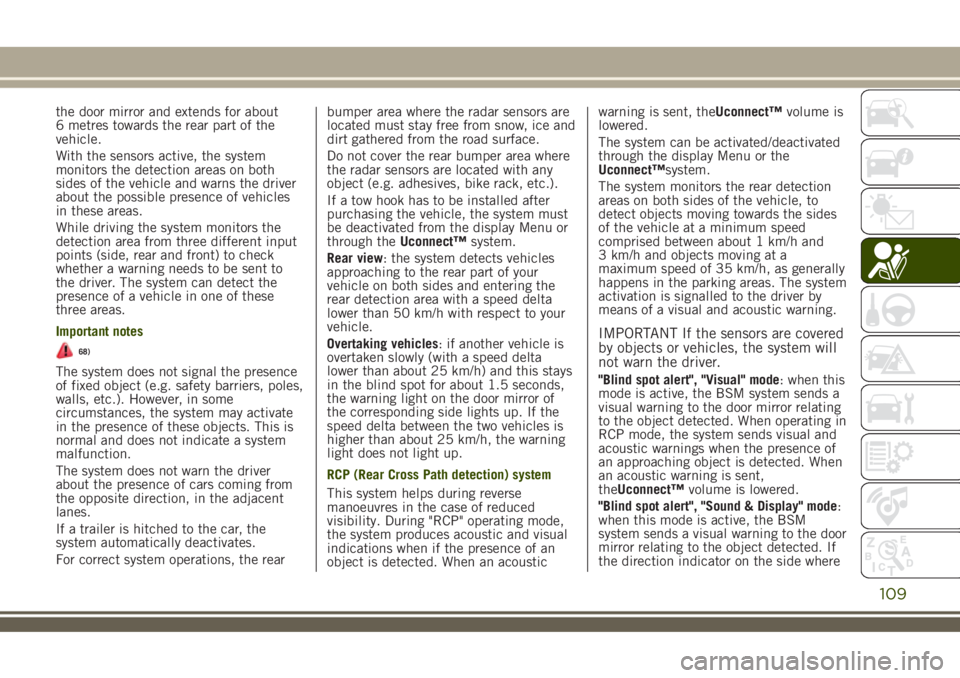
the door mirror and extends for about
6 metres towards the rear part of the
vehicle.
With the sensors active, the system
monitors the detection areas on both
sides of the vehicle and warns the driver
about the possible presence of vehicles
in these areas.
While driving the system monitors the
detection area from three different input
points (side, rear and front) to check
whether a warning needs to be sent to
the driver. The system can detect the
presence of a vehicle in one of these
three areas.
Important notes
68)
The system does not signal the presence
of fixed object (e.g. safety barriers, poles,
walls, etc.). However, in some
circumstances, the system may activate
in the presence of these objects. This is
normal and does not indicate a system
malfunction.
The system does not warn the driver
about the presence of cars coming from
the opposite direction, in the adjacent
lanes.
If a trailer is hitched to the car, the
system automatically deactivates.
For correct system operations, the rearbumper area where the radar sensors are
located must stay free from snow, ice and
dirt gathered from the road surface.
Do not cover the rear bumper area where
the radar sensors are located with any
object (e.g. adhesives, bike rack, etc.).
If a tow hook has to be installed after
purchasing the vehicle, the system must
be deactivated from the display Menu or
through theUconnect™system.
Rear view: the system detects vehicles
approaching to the rear part of your
vehicle on both sides and entering the
rear detection area with a speed delta
lower than 50 km/h with respect to your
vehicle.
Overtaking vehicles: if another vehicle is
overtaken slowly (with a speed delta
lower than about 25 km/h) and this stays
in the blind spot for about 1.5 seconds,
the warning light on the door mirror of
the corresponding side lights up. If the
speed delta between the two vehicles is
higher than about 25 km/h, the warning
light does not light up.
RCP (Rear Cross Path detection) system
This system helps during reverse
manoeuvres in the case of reduced
visibility. During "RCP" operating mode,
the system produces acoustic and visual
indications when if the presence of an
object is detected. When an acousticwarning is sent, theUconnect™volume is
lowered.
The system can be activated/deactivated
through the display Menu or the
Uconnect™system.
The system monitors the rear detection
areas on both sides of the vehicle, to
detect objects moving towards the sides
of the vehicle at a minimum speed
comprised between about 1 km/h and
3 km/h and objects moving at a
maximum speed of 35 km/h, as generally
happens in the parking areas. The system
activation is signalled to the driver by
means of a visual and acoustic warning.
IMPORTANT If the sensors are covered
by objects or vehicles, the system will
not warn the driver.
"Blind spot alert", "Visual" mode: when this
mode is active, the BSM system sends a
visual warning to the door mirror relating
to the object detected. When operating in
RCP mode, the system sends visual and
acoustic warnings when the presence of
an approaching object is detected. When
an acoustic warning is sent,
theUconnect™volume is lowered.
"Blind spot alert", "Sound & Display" mode:
when this mode is active, the BSM
system sends a visual warning to the door
mirror relating to the object detected. If
the direction indicator on the side where
109
Page 113 of 356

putting the ignition device in the MAR
position.
IMPORTANT The system status can be
changed with vehicle at a standstill
only.
Activation/deactivation
If the Forward Collision Warning Plus
system has been correctly activated with
theUconnect™system, this will be active
each time the engine is started.
To deactivate the system, hold down the
button on the central tunnel. Following
a deactivation, the system will not warn
the driver about the possible collision
with the preceding vehicle, regardless of
the setting selected with the
Uconnect™system. To reactivate the
system press the
button again.
The system is only active if:
it is activated via the
Uconnect™system;
it has not been deactivated with a long
press of thebutton;the ignition device is at MAR;the vehicle speed is between 7 and
200 km/h;
the front seat belts are fastened.System limited operation warning
If the dedicated message is displayed, a
condition limiting the system operation
may have occurred. The possible reasons
of this limitation are something blocking
the camera view or a fault. If an
obstruction is signalled, clean the area of
the windscreen indicated in fig. 75 and
check that the message has disappeared.
In this case the system might be not
completely available.
When the conditions limiting the system
functions end, this will go back to normal
and complete operation. Should the fault
persist, contact a Jeep Dealership.
Driving in special conditions
In certain driving conditions, such as, for
example:
driving close to a bend fig. 76;vehicles with small dimensions and/or
not aligned in the driving lane fig. 77;
lane change by other vehicles fig. 78;vehicles travelling at right angles to
the vehicle fig. 79;system intervention might be unexpected
or delayed. The driver must be very
careful to maintain control of the vehicle
and drive in complete safety.
76J0A0081C
77J0A0082C
111
Page 115 of 356
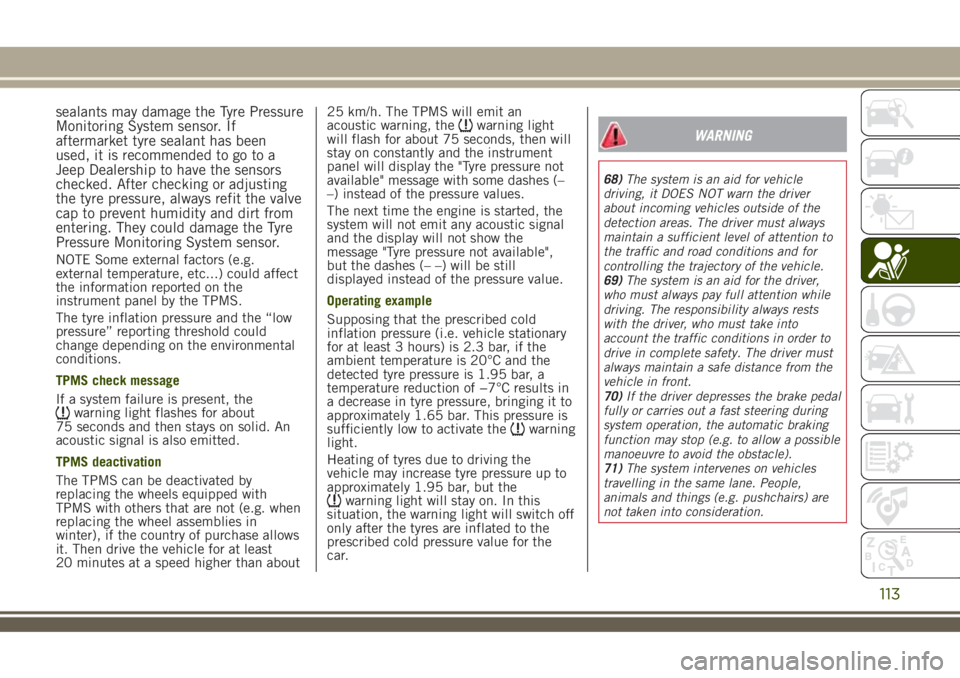
sealants may damage the Tyre Pressure
Monitoring System sensor. If
aftermarket tyre sealant has been
used, it is recommended to go to a
Jeep Dealership to have the sensors
checked. After checking or adjusting
the tyre pressure, always refit the valve
cap to prevent humidity and dirt from
entering. They could damage the Tyre
Pressure Monitoring System sensor.
NOTE Some external factors (e.g.
external temperature, etc...) could affect
the information reported on the
instrument panel by the TPMS.
The tyre inflation pressure and the “low
pressure” reporting threshold could
change depending on the environmental
conditions.
TPMS check message
If a system failure is present, the
warning light flashes for about
75 seconds and then stays on solid. An
acoustic signal is also emitted.
TPMS deactivation
The TPMS can be deactivated by
replacing the wheels equipped with
TPMS with others that are not (e.g. when
replacing the wheel assemblies in
winter), if the country of purchase allows
it. Then drive the vehicle for at least
20 minutes at a speed higher than about25 km/h. The TPMS will emit an
acoustic warning, the
warning light
will flash for about 75 seconds, then will
stay on constantly and the instrument
panel will display the "Tyre pressure not
available" message with some dashes (–
–) instead of the pressure values.
The next time the engine is started, the
system will not emit any acoustic signal
and the display will not show the
message "Tyre pressure not available",
but the dashes (– –) will be still
displayed instead of the pressure value.
Operating example
Supposing that the prescribed cold
inflation pressure (i.e. vehicle stationary
for at least 3 hours) is 2.3 bar, if the
ambient temperature is 20°C and the
detected tyre pressure is 1.95 bar, a
temperature reduction of −7°C results in
a decrease in tyre pressure, bringing it to
approximately 1.65 bar. This pressure is
sufficiently low to activate the
warning
light.
Heating of tyres due to driving the
vehicle may increase tyre pressure up to
approximately 1.95 bar, but the
warning light will stay on. In this
situation, the warning light will switch off
only after the tyres are inflated to the
prescribed cold pressure value for the
car.
WARNING
68)The system is an aid for vehicle
driving, it DOES NOT warn the driver
about incoming vehicles outside of the
detection areas. The driver must always
maintain a sufficient level of attention to
the traffic and road conditions and for
controlling the trajectory of the vehicle.
69)The system is an aid for the driver,
who must always pay full attention while
driving. The responsibility always rests
with the driver, who must take into
account the traffic conditions in order to
drive in complete safety. The driver must
always maintain a safe distance from the
vehicle in front.
70)If the driver depresses the brake pedal
fully or carries out a fast steering during
system operation, the automatic braking
function may stop (e.g. to allow a possible
manoeuvre to avoid the obstacle).
71)The system intervenes on vehicles
travelling in the same lane. People,
animals and things (e.g. pushchairs) are
not taken into consideration.
113
Page 116 of 356
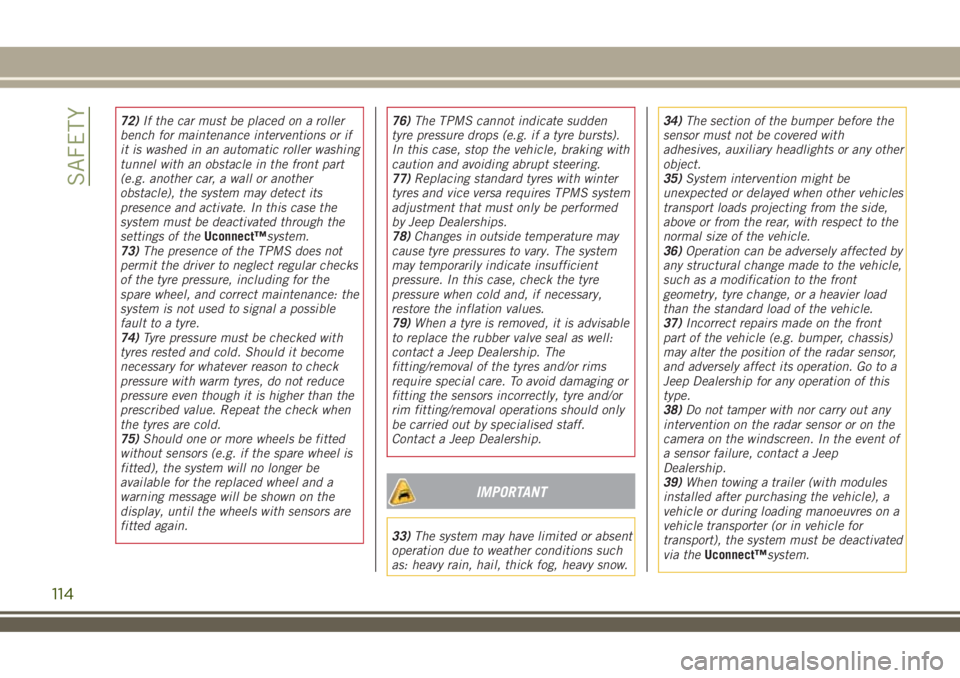
72)If the car must be placed on a roller
bench for maintenance interventions or if
it is washed in an automatic roller washing
tunnel with an obstacle in the front part
(e.g. another car, a wall or another
obstacle), the system may detect its
presence and activate. In this case the
system must be deactivated through the
settings of theUconnect™system.
73)The presence of the TPMS does not
permit the driver to neglect regular checks
of the tyre pressure, including for the
spare wheel, and correct maintenance: the
system is not used to signal a possible
fault to a tyre.
74)Tyre pressure must be checked with
tyres rested and cold. Should it become
necessary for whatever reason to check
pressure with warm tyres, do not reduce
pressure even though it is higher than the
prescribed value. Repeat the check when
the tyres are cold.
75)Should one or more wheels be fitted
without sensors (e.g. if the spare wheel is
fitted), the system will no longer be
available for the replaced wheel and a
warning message will be shown on the
display, until the wheels with sensors are
fitted again.76)The TPMS cannot indicate sudden
tyre pressure drops (e.g. if a tyre bursts).
In this case, stop the vehicle, braking with
caution and avoiding abrupt steering.
77)Replacing standard tyres with winter
tyres and vice versa requires TPMS system
adjustment that must only be performed
by Jeep Dealerships.
78)Changes in outside temperature may
cause tyre pressures to vary. The system
may temporarily indicate insufficient
pressure. In this case, check the tyre
pressure when cold and, if necessary,
restore the inflation values.
79)When a tyre is removed, it is advisable
to replace the rubber valve seal as well:
contact a Jeep Dealership. The
fitting/removal of the tyres and/or rims
require special care. To avoid damaging or
fitting the sensors incorrectly, tyre and/or
rim fitting/removal operations should only
be carried out by specialised staff.
Contact a Jeep Dealership.
IMPORTANT
33)The system may have limited or absent
operation due to weather conditions such
as: heavy rain, hail, thick fog, heavy snow.34)The section of the bumper before the
sensor must not be covered with
adhesives, auxiliary headlights or any other
object.
35)System intervention might be
unexpected or delayed when other vehicles
transport loads projecting from the side,
above or from the rear, with respect to the
normal size of the vehicle.
36)Operation can be adversely affected by
any structural change made to the vehicle,
such as a modification to the front
geometry, tyre change, or a heavier load
than the standard load of the vehicle.
37)Incorrect repairs made on the front
part of the vehicle (e.g. bumper, chassis)
may alter the position of the radar sensor,
and adversely affect its operation. Go to a
Jeep Dealership for any operation of this
type.
38)Do not tamper with nor carry out any
intervention on the radar sensor or on the
camera on the windscreen. In the event of
a sensor failure, contact a Jeep
Dealership.
39)When towing a trailer (with modules
installed after purchasing the vehicle), a
vehicle or during loading manoeuvres on a
vehicle transporter (or in vehicle for
transport), the system must be deactivated
via theUconnect™system.
114
SAFETY
Page 117 of 356
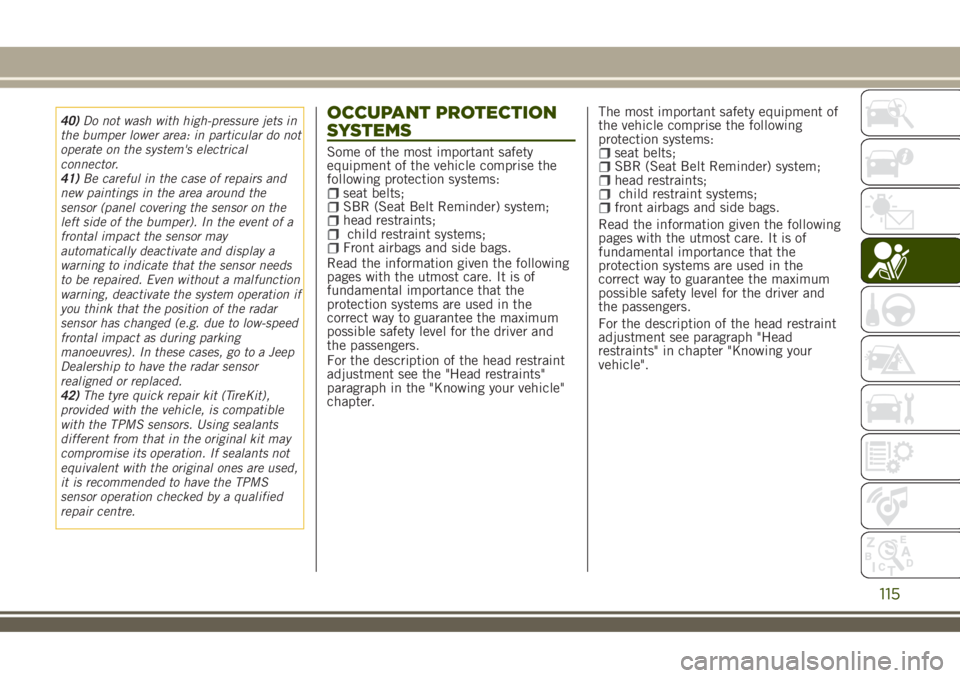
40)Do not wash with high-pressure jets in
the bumper lower area: in particular do not
operate on the system's electrical
connector.
41)Be careful in the case of repairs and
new paintings in the area around the
sensor (panel covering the sensor on the
left side of the bumper). In the event of a
frontal impact the sensor may
automatically deactivate and display a
warning to indicate that the sensor needs
to be repaired. Even without a malfunction
warning, deactivate the system operation if
you think that the position of the radar
sensor has changed (e.g. due to low-speed
frontal impact as during parking
manoeuvres). In these cases, go to a Jeep
Dealership to have the radar sensor
realigned or replaced.
42)The tyre quick repair kit (TireKit),
provided with the vehicle, is compatible
with the TPMS sensors. Using sealants
different from that in the original kit may
compromise its operation. If sealants not
equivalent with the original ones are used,
it is recommended to have the TPMS
sensor operation checked by a qualified
repair centre.OCCUPANT PROTECTION
SYSTEMS
Some of the most important safety
equipment of the vehicle comprise the
following protection systems:
seat belts;SBR (Seat Belt Reminder) system;head restraints;child restraint systems;Front airbags and side bags.
Read the information given the following
pages with the utmost care. It is of
fundamental importance that the
protection systems are used in the
correct way to guarantee the maximum
possible safety level for the driver and
the passengers.
For the description of the head restraint
adjustment see the "Head restraints"
paragraph in the "Knowing your vehicle"
chapter.The most important safety equipment of
the vehicle comprise the following
protection systems:
seat belts;SBR (Seat Belt Reminder) system;head restraints;child restraint systems;front airbags and side bags.
Read the information given the following
pages with the utmost care. It is of
fundamental importance that the
protection systems are used in the
correct way to guarantee the maximum
possible safety level for the driver and
the passengers.
For the description of the head restraint
adjustment see paragraph "Head
restraints" in chapter "Knowing your
vehicle".
115
Page 119 of 356
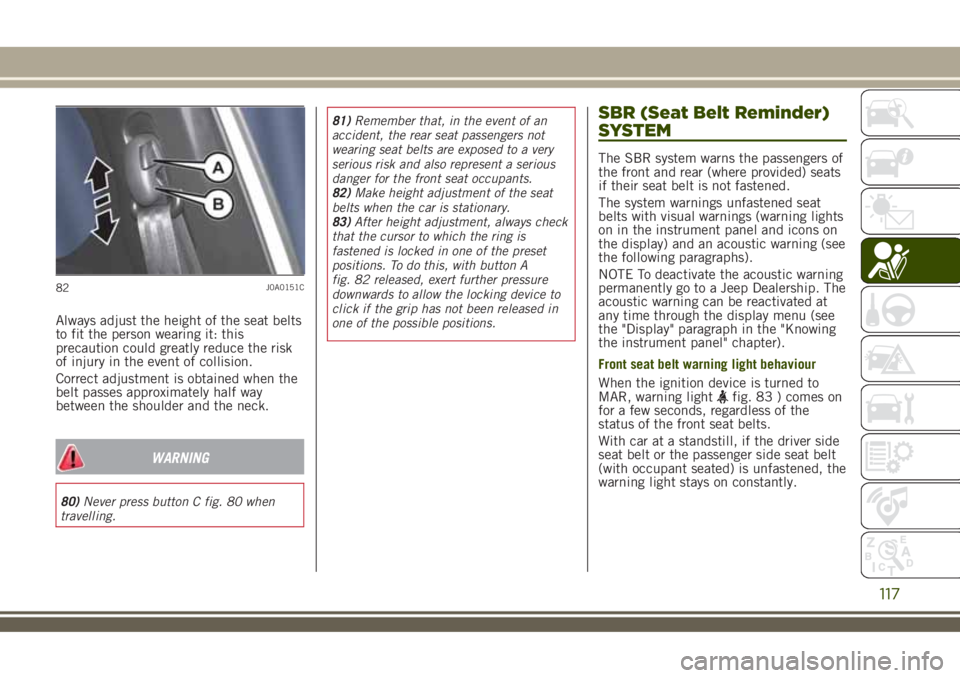
Always adjust the height of the seat belts
to fit the person wearing it: this
precaution could greatly reduce the risk
of injury in the event of collision.
Correct adjustment is obtained when the
belt passes approximately half way
between the shoulder and the neck.
WARNING
80)Never press button C fig. 80 when
travelling.81)Remember that, in the event of an
accident, the rear seat passengers not
wearing seat belts are exposed to a very
serious risk and also represent a serious
danger for the front seat occupants.
82)Make height adjustment of the seat
belts when the car is stationary.
83)After height adjustment, always check
that the cursor to which the ring is
fastened is locked in one of the preset
positions. To do this, with button A
fig. 82 released, exert further pressure
downwards to allow the locking device to
click if the grip has not been released in
one of the possible positions.
SBR (Seat Belt Reminder)
SYSTEM
The SBR system warns the passengers of
the front and rear (where provided) seats
if their seat belt is not fastened.
The system warnings unfastened seat
belts with visual warnings (warning lights
on in the instrument panel and icons on
the display) and an acoustic warning (see
the following paragraphs).
NOTE To deactivate the acoustic warning
permanently go to a Jeep Dealership. The
acoustic warning can be reactivated at
any time through the display menu (see
the "Display" paragraph in the "Knowing
the instrument panel" chapter).
Front seat belt warning light behaviour
When the ignition device is turned to
MAR, warning light
fig. 83 ) comes on
for a few seconds, regardless of the
status of the front seat belts.
With car at a standstill, if the driver side
seat belt or the passenger side seat belt
(with occupant seated) is unfastened, the
warning light stays on constantly.
82J0A0151C
117
Page 120 of 356
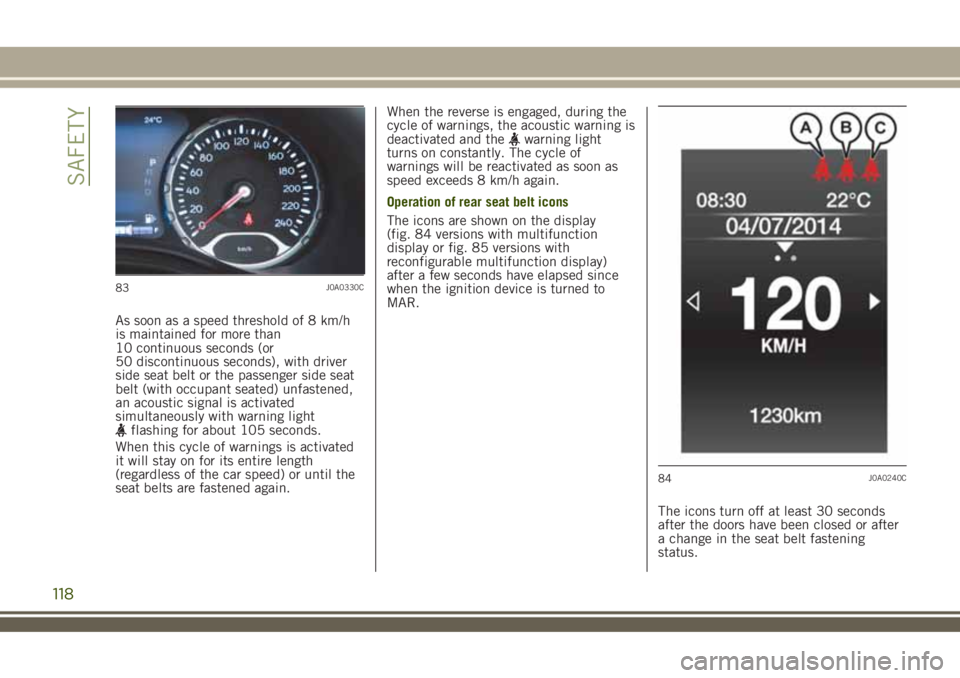
As soon as a speed threshold of 8 km/h
is maintained for more than
10 continuous seconds (or
50 discontinuous seconds), with driver
side seat belt or the passenger side seat
belt (with occupant seated) unfastened,
an acoustic signal is activated
simultaneously with warning light
flashing for about 105 seconds.
When this cycle of warnings is activated
it will stay on for its entire length
(regardless of the car speed) or until the
seat belts are fastened again.When the reverse is engaged, during the
cycle of warnings, the acoustic warning is
deactivated and the
warning light
turns on constantly. The cycle of
warnings will be reactivated as soon as
speed exceeds 8 km/h again.
Operation of rear seat belt icons
The icons are shown on the display
(fig. 84 versions with multifunction
display or fig. 85 versions with
reconfigurable multifunction display)
after a few seconds have elapsed since
when the ignition device is turned to
MAR.
The icons turn off at least 30 seconds
after the doors have been closed or after
a change in the seat belt fastening
status.
83J0A0330C
84J0A0240C
118
SAFETY
Page 121 of 356

The icons shown on the display indicate:A: rear left seat belt;B: rear central seat belt;C: rear right seat belt.
NOTE On versions equipped with
multifunction display, if a seat belt is
unfastened, the
icon lights up.
The icons are displayed according to the
corresponding seat belts in the rear
seats, and stay on for about 30 seconds
from the last seat belt status change:
if the seat belt is fastenedthe
corresponding icon will be green;
if the seat belt is unfastenedthe
corresponding icon will be red.
If a rear seat belt is unfastened, an
acoustic warning (3 "beeps") will beactivated along with the relevant icon
lighting up in the display.
Furthermore the icons will light up again
for 90 seconds each time one of the rear
doors is closed.
The icon will turn green after the
corresponding seat belt has been
fastened.
The rear seat icons will go out, regardless
of the state of the belt (red icon or green
icon), approximately 30 seconds after the
last signal.
IMPORTANT NOTES
As far as the rear seats are concerned,
the SBR system will only indicate
whether the seat belts are unfastened
(red icon) or fastened (green icon), not
the presence of any passengers.
The warning lights/icons are all off if all
seat belts (front and rear) are fastened
when the ignition device is at MAR.
For the rear seats, the icons will activate
a few seconds after the ignition device
has been turned to MAR, regardless of
the status of the seat belts (even if the
seat belts are all fastened).
All the warning lights/icons will come on
when at least one belt changes from
fastened to unfastened status or vice
versa.
PRETENSIONERS
84) 85) 86) 87)43)
The vehicle is equipped with front seat
belt pretensioners, which draw back the
seat belts by several centimetres in the
event of a strong frontal impact. This
guarantees the perfect adherence of the
seat belts to the occupant's bodies before
the retention action begins.
It is evident that the pretensioners have
been activated when the belt withdraws
toward the retractor.
This vehicle is also equipped with a
second pretensioner (fitted in the kick
plate area). Its activation is signalled by
the shortening of the metal cable.
A slight discharge of smoke may be
produced during the activation of the
pretensioner which is not harmful and
does not indicate any fire hazard.
The pretensioner does not require any
maintenance or lubrication: any changes
to its original conditions will invalidate
its efficiency.
If, due to unusual natural events (floods,
sea storms, etc.), the device has been
affected by water and/or mud, contact a
Jeep Dealership to have it replaced.
IMPORTANT To obtain the highest
degree of protection from the action of
85J0A0245C
119
Page 138 of 356
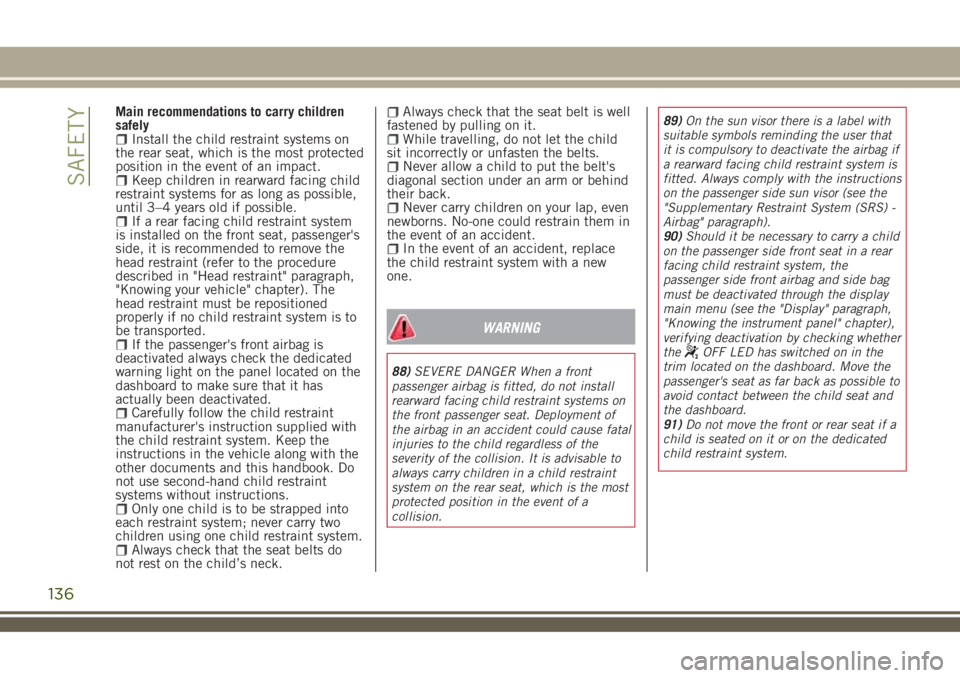
Main recommendations to carry children
safely
Install the child restraint systems on
the rear seat, which is the most protected
position in the event of an impact.
Keep children in rearward facing child
restraint systems for as long as possible,
until 3–4 years old if possible.
If a rear facing child restraint system
is installed on the front seat, passenger's
side, it is recommended to remove the
head restraint (refer to the procedure
described in "Head restraint" paragraph,
"Knowing your vehicle" chapter). The
head restraint must be repositioned
properly if no child restraint system is to
be transported.
If the passenger's front airbag is
deactivated always check the dedicated
warning light on the panel located on the
dashboard to make sure that it has
actually been deactivated.
Carefully follow the child restraint
manufacturer's instruction supplied with
the child restraint system. Keep the
instructions in the vehicle along with the
other documents and this handbook. Do
not use second-hand child restraint
systems without instructions.
Only one child is to be strapped into
each restraint system; never carry two
children using one child restraint system.
Always check that the seat belts do
not rest on the child’s neck.
Always check that the seat belt is well
fastened by pulling on it.
While travelling, do not let the child
sit incorrectly or unfasten the belts.
Never allow a child to put the belt's
diagonal section under an arm or behind
their back.
Never carry children on your lap, even
newborns. No-one could restrain them in
the event of an accident.
In the event of an accident, replace
the child restraint system with a new
one.
WARNING
88)SEVERE DANGER When a front
passenger airbag is fitted, do not install
rearward facing child restraint systems on
the front passenger seat. Deployment of
the airbag in an accident could cause fatal
injuries to the child regardless of the
severity of the collision. It is advisable to
always carry children in a child restraint
system on the rear seat, which is the most
protected position in the event of a
collision.89)On the sun visor there is a label with
suitable symbols reminding the user that
it is compulsory to deactivate the airbag if
a rearward facing child restraint system is
fitted. Always comply with the instructions
on the passenger side sun visor (see the
"Supplementary Restraint System (SRS) -
Airbag" paragraph).
90)Should it be necessary to carry a child
on the passenger side front seat in a rear
facing child restraint system, the
passenger side front airbag and side bag
must be deactivated through the display
main menu (see the "Display" paragraph,
"Knowing the instrument panel" chapter),
verifying deactivation by checking whether
the
OFF LED has switched on in the
trim located on the dashboard. Move the
passenger's seat as far back as possible to
avoid contact between the child seat and
the dashboard.
91)Do not move the front or rear seat if a
child is seated on it or on the dedicated
child restraint system.
136
SAFETY
Page 141 of 356
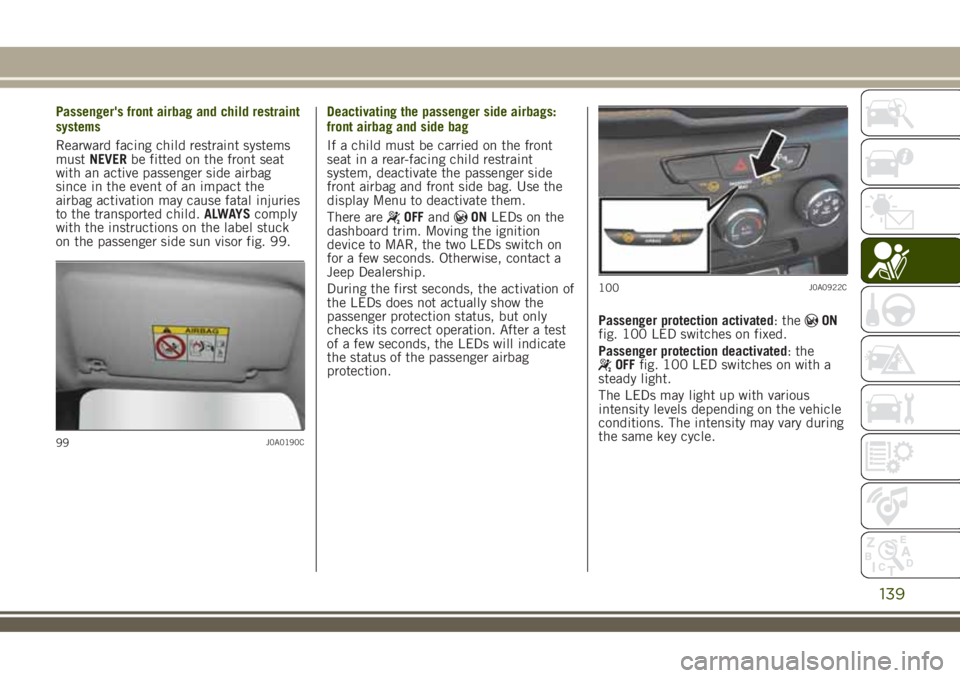
Passenger's front airbag and child restraint
systems
Rearward facing child restraint systems
mustNEVERbe fitted on the front seat
with an active passenger side airbag
since in the event of an impact the
airbag activation may cause fatal injuries
to the transported child.ALWAYScomply
with the instructions on the label stuck
on the passenger side sun visor fig. 99.Deactivating the passenger side airbags:
front airbag and side bag
If a child must be carried on the front
seat in a rear-facing child restraint
system, deactivate the passenger side
front airbag and front side bag. Use the
display Menu to deactivate them.
There are
OFFandONLEDs on the
dashboard trim. Moving the ignition
device to MAR, the two LEDs switch on
for a few seconds. Otherwise, contact a
Jeep Dealership.
During the first seconds, the activation of
the LEDs does not actually show the
passenger protection status, but only
checks its correct operation. After a test
of a few seconds, the LEDs will indicate
the status of the passenger airbag
protection.Passenger protection activated: the
ON
fig. 100 LED switches on fixed.
Passenger protection deactivated: the
OFFfig. 100 LED switches on with a
steady light.
The LEDs may light up with various
intensity levels depending on the vehicle
conditions. The intensity may vary during
the same key cycle.
99J0A0190C
100J0A0922C
139